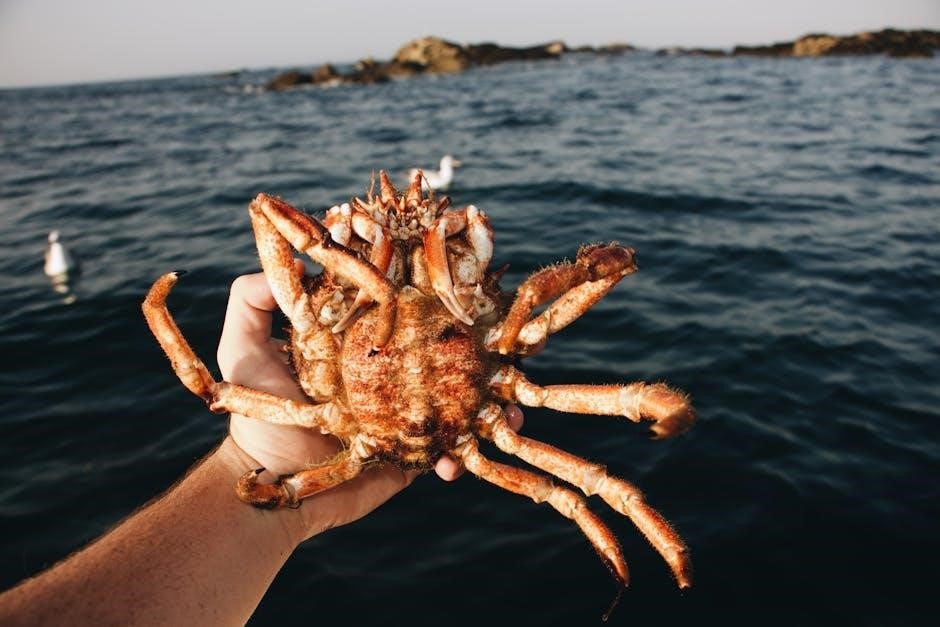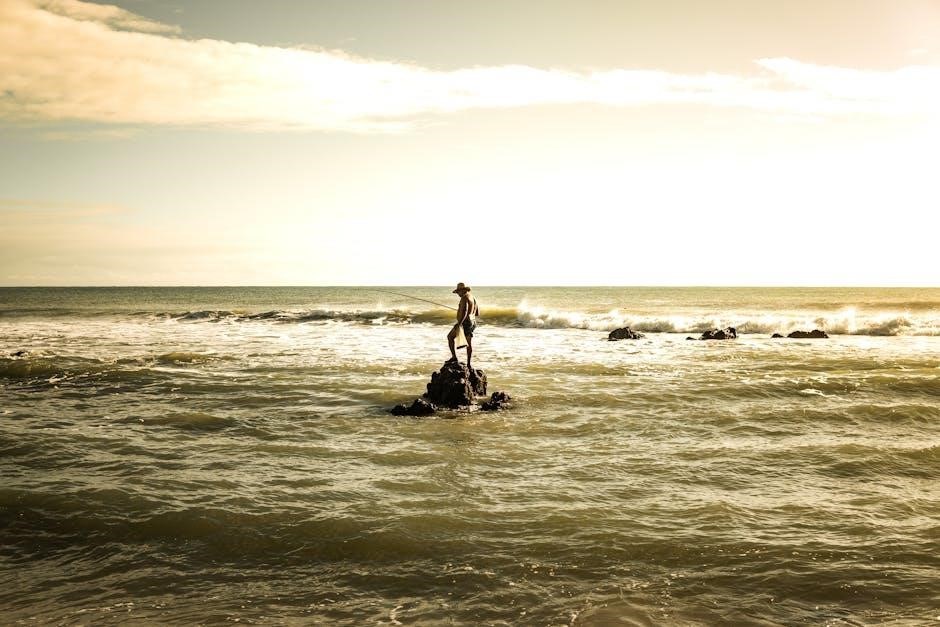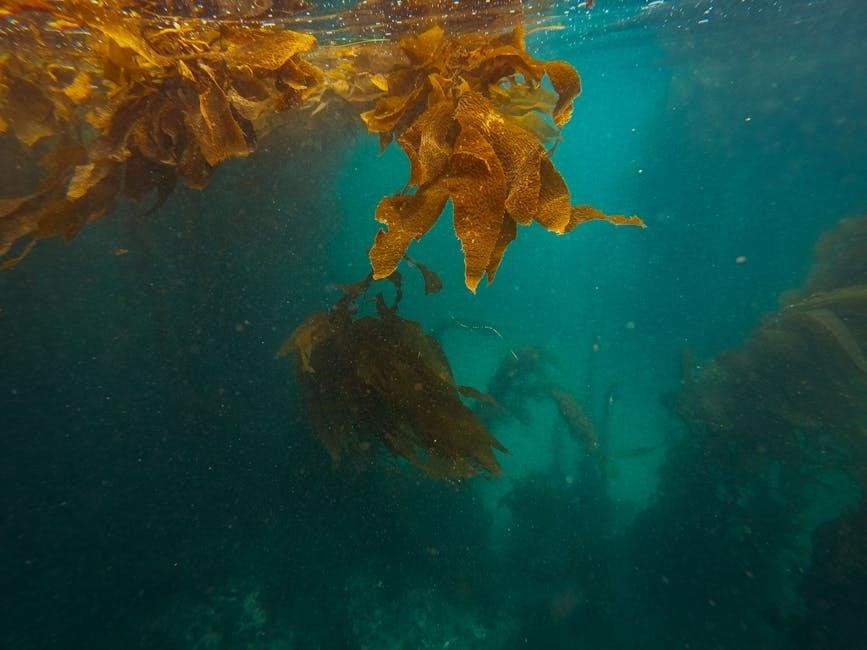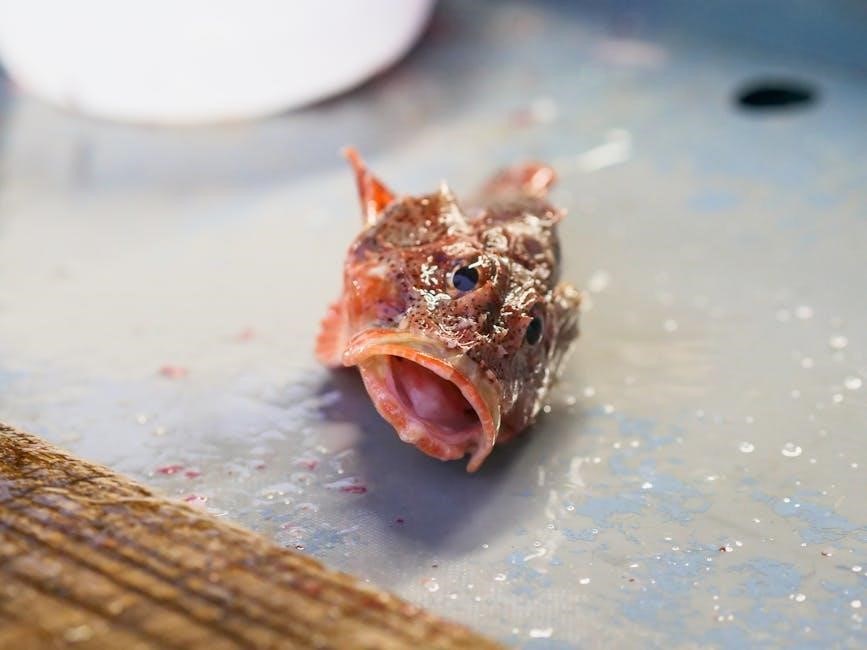saltwater fishing guide

Saltwater fishing offers an exhilarating experience‚ connecting anglers with nature while targeting diverse marine species․ This guide provides insights into gear‚ techniques‚ and prime locations‚ catering to both beginners and seasoned enthusiasts․
What is Saltwater Fishing?

Saltwater fishing is the practice of angling in marine environments‚ including oceans‚ estuaries‚ and coastal areas․ It involves targeting various species of fish and marine life that inhabit these ecosystems․ Unlike freshwater fishing‚ saltwater fishing often requires specialized gear and techniques due to the unique conditions of the marine environment․ Anglers engage in this activity for recreation‚ sport‚ or sustenance‚ with opportunities to catch species like marlin‚ tuna‚ tarpon‚ and many others․ Saltwater fishing can range from shore-based casting to deep-sea expeditions‚ offering diverse experiences for both novice and experienced anglers․ Understanding the basics of saltwater fishing is essential for success and sustainability in this rewarding outdoor pursuit․
Benefits of Saltwater Fishing
Saltwater fishing offers a unique combination of adventure‚ relaxation‚ and personal growth․ It provides an opportunity to connect with nature‚ enjoy the tranquility of the ocean‚ and challenge oneself by targeting diverse marine species․ For many‚ it serves as a form of stress relief‚ fostering mental and physical well-being․ The activity also encourages social bonding‚ as anglers often share experiences and tips with fellow enthusiasts․ Additionally‚ saltwater fishing helps develop patience‚ persistence‚ and a deeper appreciation for marine ecosystems․ Whether for recreation or sport‚ it creates lasting memories and a sense of accomplishment with each successful catch․ Moreover‚ it promotes environmental awareness‚ inspiring conservation efforts to protect marine life and habitats for future generations․
Essential Gear for Saltwater Fishing
Saltwater fishing requires durable rods‚ reels‚ and lines designed for marine conditions․ Lures‚ bait‚ hooks‚ and tackle boxes are also crucial for a successful fishing experience․
Rods and Reels
Choosing the right rods and reels is essential for saltwater fishing․ Saltwater rods are typically longer and sturdier than freshwater rods‚ designed to handle larger fish and corrosive marine environments․ Graphite and fiberglass rods are popular for their sensitivity and durability․ Reels should be saltwater-specific‚ with sealed drag systems to prevent corrosion․ Spinning‚ baitcasting‚ and trolling reels are common types‚ each suited for different fishing techniques․ A medium to heavy action rod-and-reel combo is ideal for most saltwater species‚ ensuring strength and control․ Properly maintained gear can withstand the harsh conditions of saltwater fishing‚ making it a worthwhile investment for any angler․
Fishing Lines and Leaders
Fishing lines and leaders are crucial components in saltwater fishing‚ ensuring strength and durability against marine conditions․ Monofilament and fluorocarbon lines are popular choices‚ offering abrasion resistance and sensitivity․ Monofilament lines are versatile and suitable for most saltwater species‚ while fluorocarbon lines are nearly invisible underwater‚ reducing fish spooking․ Leaders‚ typically made of monofilament or fluorocarbon‚ connect the main line to the lure or bait‚ protecting against sharp teeth and underwater structures․ Leader length and pound test vary depending on the target species and water clarity․ In clear waters‚ longer leaders with lighter pound tests are effective‚ whereas in murky conditions‚ shorter‚ heavier leaders are preferred․ Properly selected lines and leaders enhance casting performance and increase the chances of successful catches in saltwater environments․
Lures and Bait
Lures and bait are essential for attracting saltwater fish‚ with options catering to different species and fishing conditions․ Natural baits‚ such as live shrimp‚ squid‚ and baitfish‚ mimic the natural food sources of marine species‚ increasing the chances of a bite․ Artificial lures‚ including spoons‚ jigs‚ and plugs‚ offer versatility and durability‚ often simulating injured prey to provoke strikes․ Soft plastic lures‚ like curly tail grubs‚ are effective for bottom-dwelling fish‚ while topwater lures excite surface feeders․ Choosing the right bait or lure depends on the target species‚ water clarity‚ and fishing technique․ Combining natural bait with artificial lures can enhance appeal‚ making it a strategic approach for saltwater anglers seeking diverse catches․
Tackle Box Essentials
A well-stocked tackle box is crucial for saltwater fishing success․ Include a variety of hooks‚ ranging from small bait holders to large circle hooks‚ suitable for different fish sizes and types․ Swivels and sinkers are vital for managing line twists and reaching desired depths․ Pliers or a dehooker are essential for safely removing hooks from caught fish․ A selection of lures‚ such as spoons‚ jigs‚ and soft plastics‚ caters to diverse fishing scenarios․ Bobbers and floats help suspend bait or lures at specific levels․ Additionally‚ include line cutters‚ leaders‚ and an assortment of knots and rigs․ Organizing your tackle box ensures quick access to gear‚ enhancing efficiency and enjoyment during your fishing adventure․ A comprehensive setup allows you to adapt to varying conditions and target multiple species effectively․

Best Locations for Saltwater Fishing
Coastal areas‚ estuaries‚ mangroves‚ coral reefs‚ and offshore waters offer diverse saltwater fishing opportunities․ These locations attract a wide range of species‚ providing ideal spots for anglers of all skill levels․
Coastal Areas and Beaches
Coastal areas and beaches are prime locations for saltwater fishing‚ offering access to a variety of species like striped bass‚ tarpon‚ and snook․ These spots are ideal for surf fishing‚ where anglers cast directly into the waves․ Beaches with structures such as piers‚ jetties‚ and sandbars attract larger fish‚ making them hotspots for anglers․ The changing tides create dynamic conditions‚ with fish moving into shallower waters during high tide and retreating to deeper areas during low tide․ For beginners‚ beaches provide easy access and a forgiving environment to practice casting and technique․ Seasoned anglers also appreciate the challenge of reading the surf and identifying where fish are likely to be feeding․ Overall‚ coastal areas and beaches offer some of the most accessible and rewarding saltwater fishing experiences․
Estuaries and Mangroves
Estuaries and mangroves are vibrant ecosystems teeming with marine life‚ making them exceptional spots for saltwater fishing․ These areas serve as nurseries for juvenile fish and attract species like snook‚ tarpon‚ and redfish․ Mangroves provide shelter and ambush points‚ while estuaries offer a mix of fresh and saltwater‚ creating a dynamic environment․ Anglers can fish near river mouths‚ tidal creeks‚ or mangrove roots‚ where baitfish congregate․ Tidal movements significantly influence fish behavior here‚ with high tides bringing fish into shallower waters․ Techniques like casting lures or using live bait are effective․ These habitats are biodiversity hotspots‚ and their conservation is crucial for sustaining fish populations․ For anglers seeking diverse species and challenging fishing‚ estuaries and mangroves are unparalleled destinations․
Coral Reefs and Offshore Waters
Coral reefs and offshore waters offer some of the most thrilling saltwater fishing experiences․ Coral reefs are bustling with marine life‚ attracting species like grouper‚ snapper‚ and barracuda․ These structures provide ambush points for predators‚ making them hotspots for anglers․ Offshore waters‚ often reached by boat‚ are home to pelagic species such as tuna‚ mahi-mahi‚ and marlin․ Deep-sea fishing in these areas requires sturdy gear and techniques like trolling or bottom fishing․ The open ocean’s vastness and varying depths create diverse habitats‚ from reefs to drop-offs‚ where fish thrive․ Conservation efforts are crucial here‚ as coral reefs are fragile ecosystems․ Anglers must practice sustainable fishing to protect these vital marine environments while enjoying the excitement of reeling in prized catches․
Saltwater Fishing Techniques
Saltwater fishing techniques vary‚ including casting‚ trolling‚ and bottom fishing․ Anglers must master knot tying and reading water conditions to succeed in diverse marine environments effectively․
Casting Techniques
Casting is a fundamental skill in saltwater fishing‚ requiring precision and practice․ The overhand cast is the most common‚ suitable for most scenarios․ To execute it‚ hold the rod at a 45-degree angle‚ snap your wrist to generate power‚ and release the line when the rod tip reaches your target․ For longer distances‚ use a roll cast to minimize line splash․ In windy conditions‚ a pendulum cast can help maintain accuracy․ Practice different casting styles to adapt to varying conditions and species․ Proper casting techniques ensure your lure or bait lands precisely where fish are likely to strike‚ enhancing your chances of a successful catch․ Mastery of casting is key to effective saltwater fishing․
Knot Tying
Knot tying is a critical skill for saltwater fishing‚ ensuring secure connections between lines‚ lures‚ and hooks․ The Clinch Knot is a reliable choice for attaching lures or hooks to the fishing line․ The Palomar Knot is ideal for tying swivels or hooks‚ offering exceptional strength․ For joining two lines‚ the Blood Knot is effective‚ while the Surgeon’s Knot is perfect for connecting monofilament or fluorocarbon lines․ Properly tying knots prevents line breakage and lost catches․ Practice these knots to build confidence and ensure a successful fishing experience․ A well-tied knot is the foundation of saltwater fishing‚ making it essential to master these techniques for optimal results․
Reading the Water
Reading the water is a fundamental skill in saltwater fishing‚ enabling anglers to identify potential hotspots for fish․ Observe wave patterns‚ structure‚ and depth changes to locate schools․ Look for ripples‚ baitfish activity‚ and color variations in the water‚ as these often indicate fish presence․ Coral reefs‚ rocky outcrops‚ and mangrove edges are prime spots․ Pay attention to tidal movements‚ as they influence fish behavior․ Understanding these elements helps anglers make informed decisions about casting locations and techniques․ Mastery of water reading enhances success and is a key part of a rewarding saltwater fishing experience․

Tips for Success
Mastering tides‚ using appropriate bait‚ and maintaining patience are key to success in saltwater fishing․ Understanding fish behavior and respecting marine ecosystems ensure a rewarding experience․
Best Times to Fish
The best times for saltwater fishing vary based on tidal movements‚ weather conditions‚ and the target species․ Generally‚ dawn and dusk are prime periods as fish are most active during these times․
Rising tides often stimulate feeding behavior‚ while falling tides can concentrate fish in smaller areas․ Weather plays a significant role; overcast skies and calm seas typically improve catch rates․ Seasonal patterns also influence fish activity‚ with certain species more abundant during specific months․ Anglers should research local fish behavior and adjust their schedules accordingly․ Understanding these factors enhances the likelihood of a successful fishing trip and makes the experience more enjoyable for both beginners and experienced anglers․

Conservation Practices
Conservation practices are essential for maintaining healthy marine ecosystems and ensuring sustainable saltwater fishing․ Anglers should adopt catch-and-release techniques to minimize fish mortality‚ using barbless hooks to reduce injury․ Handling fish gently and avoiding touching their gills or eyes helps preserve their health for release․ Avoiding undersized or spawning fish protects vulnerable populations․ Familiarizing yourself with local regulations‚ such as bag limits and size restrictions‚ is crucial․ NOAA Fisheries provides data on recreational catches‚ aiding conservation efforts․ Promoting sustainable practices‚ like reducing bycatch and avoiding habitat damage‚ supports marine biodiversity․ By adhering to these guidelines‚ anglers contribute to the long-term health of marine ecosystems‚ ensuring future generations can enjoy saltwater fishing․ Responsible fishing practices benefit both the environment and the fishing community․
Safety Precautions
Safety is paramount in saltwater fishing to ensure a enjoyable and risk-free experience․ Always check weather forecasts and sea conditions before heading out‚ as rough seas or sudden storms can pose dangers․ Wear a properly fitted life jacket and ensure all safety gear‚ such as flares and a first aid kit‚ are onboard․ Inform someone ashore of your fishing plans‚ including your destination and expected return time․ Stay alert to surroundings‚ including other boats and swimmers‚ to avoid collisions․ Handle sharp fishing gear with care to prevent injuries․ Be mindful of slippery decks and secure loose items to prevent accidents․ Respect marine environments and other anglers to promote a safe and enjoyable experience for everyone․ Prioritizing safety ensures a memorable and secure fishing adventure․
Saltwater fishing is a rewarding experience that combines skill‚ patience‚ and a deep connection with nature․ This guide has covered essential gear‚ proven techniques‚ and prime locations to enhance your fishing adventures․ Remember‚ safety and conservation are key to ensuring sustainable and enjoyable fishing for years to come․ By adopting responsible practices and respecting marine environments‚ you contribute to preserving the sport for future generations․ Whether you’re reeling in a trophy catch or simply enjoying the serene beauty of the ocean‚ saltwater fishing offers unforgettable memories․ Keep exploring‚ learning‚ and appreciating the beauty of our marine world while safeguarding it for the future․





